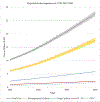The Rising Costs of Alcohol-Associated Liver Disease in the United States
- PMID: 37463414
- PMCID: PMC10872874
- DOI: 10.14309/ajg.0000000000002405
The Rising Costs of Alcohol-Associated Liver Disease in the United States
Abstract
Introduction: Alcohol-associated liver disease (ALD) is rising in the United States because of an increase in high-risk drinking, but population-level ALD cost is unknown. Our aim was to project the direct and indirect costs associated with ALD in the US population through 2040.
Methods: We used a previously validated microsimulation model of alcohol consumption and ALD with model parameters estimated from publicly available data sources, including the National Epidemiologic Survey Alcohol and Related Conditions-III, the Center for Disease Control and Prevention Wide-ranging Online Data for Epidemiologic Research, the Bureau of Labor Statistics, and published studies informing the impact of alcohol consumption on ALD severity in the United States resident population. The simulated scenario included current and projected ALD-associated costs.
Results: From 2022 to 2040, the ALD is projected to cost $880 billion, $355 billion in direct healthcare-related costs, and $525 billion in lost labor and economic consumption. The annual cost of ALD is projected to increase from $31 billion in 2022 to $66 billion (118% increase) in 2040. Although the female population makes up 29% of these costs in 2022, by 2040 on a per annum basis, female costs would be 43% of the total annual expenditure.
Discussion: Increased consumption of alcohol in the US population, especially in females, will cause a steep rise in the economic burden of ALD in the United States. These findings highlight the need for planners and policymakers to plan for the increased impact of liver disease in the United States.
Copyright © 2023 by The American College of Gastroenterology.
Conflict of interest statement
Figures





References
-
- Barbosa C, Karriker-Jaffe K, Dowd W. One Year Later: How Have American Drinking Habits Changed During the COVID-19 Pandemic. RTI International. https://www.rti.org/event/one-year-later-how-have-american-drinking-habi.... Published 2021. Accessed 2021, August.
Publication types
MeSH terms
Grants and funding
LinkOut - more resources
Full Text Sources

